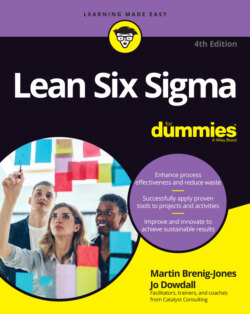Читать книгу Lean Six Sigma For Dummies - Martin Brenig-Jones - Страница 8
ОглавлениеIntroduction
Lean Six Sigma provides a rigorous and structured approach to help manage and improve quality and performance, and to solve potentially complex problems. It helps you use the right tools, in the right place and in the right way, not just in process improvement projects but also in your day-to-day work. Lean Six Sigma really is about getting key principles and concepts into the DNA and lifeblood of your organization so that it becomes a natural part of how you do things.
This book is for practitioners using Lean Six Sigma as well as those who are seeking to “lead and live” Lean Six Sigma in their organizations.
We began to blend Lean and Six Sigma together more than 20 years ago, welcoming a pragmatic rather than purist approach. We discovered how essential it has been to consider people and Change Management when improving processes too — leading to higher levels of acceptance and more effective change.
In this 4th Edition of Lean Six Sigma For Dummies, we have added a few more ingredients into the cocktail. You can find out how Agile approaches (and an Agile mindset) can accelerate results. We also discuss how Design Thinking approaches, tools, and techniques for creativity can encourage different thinking about the way the work gets done. This stuff really works.
About This Book
This book makes Lean Six Sigma easy to understand and apply. We wrote it because we know that Lean Six Sigma can help organizations of all shapes and sizes, both private and public, improve their performance in meeting their customers’ requirements. We know this because we have seen it!
We also wanted to demonstrate a pragmatic approach and the genuine synergy achieved through the combination of Lean and Six Sigma. For some reason unknown to us, a few people still feel they can use only Lean or Six Sigma, but not both. How wrong they are! In this book, you can discover how to create genuine synergy by applying the principles of Lean and Six Sigma together in your day-to-day operations and activities. And not just that: Change Management, Agile, Design Thinking and Design for Six Sigma are included too. In the true spirit of Continuous Improvement, we are always looking to enhance the approach, adapt the toolkit, and learn as we go.
Foolish Assumptions
In Lean Six Sigma, avoiding the tendency to jump to conclusions and make assumptions about things is crucial. Lean Six Sigma really is about managing by fact. Despite that, we’ve made some assumptions about why you may have bought this book:
You’re contemplating applying Lean Six Sigma in your business or organization, and you need to understand what you’re getting yourself into.
Your business is implementing Lean Six Sigma and you need to get up to speed. Perhaps you’ve been lined up to participate in the program in some way.
Your business has already implemented either Lean or Six Sigma and you’re intrigued by what you might be missing.
You’re considering a career or job change and feel that your CV or resume will look much better if you can somehow incorporate Lean or Six Sigma into it.
You’re looking to boost the results and progress of your Lean Six Sigma program and are considering how approaches like Change Management, Agile, and Design Thinking can help.
You’re a student in business, operations or industrial engineering, for example, and you realize that Lean Six Sigma could help shape your future.
We also assume that you realize that Lean Six Sigma demands a rigorous and structured approach to understanding how your work gets done and how well it gets done, and how to go about the improvement of your processes.
Icons Used In This Book
Throughout the book, you’ll see small symbols called icons in the margins; these highlight special types of information. We use these to help you better understand and apply the material. Look out for the following icons:
Keep your eyes on the target to find tips and tricks we share to help you make the most of Lean Six Sigma.
Bear these important points in mind as you get to grips with Lean Six Sigma.
Throughout this book, we share true stories of how different companies have implemented Lean Six Sigma to improve their processes.
This icon highlights potential pitfalls to avoid.
Beyond This Book
In addition to the material in the print or e-book you’re reading right now, this book also comes with some access-anywhere goodies on the web. To view the free Cheat Sheet, go to www.dummies.com and type “Lean Six Sigma For Dummies Cheat Sheet” in the search box.
Where to Go From Here
In theory, when you read you begin with ABC, and when you sing you begin with doh-ray-me (thank you Julie Andrews). But with a For Dummies book, you can begin where you like. Each part and, indeed, each chapter is self-contained, which means you can start with whichever parts or chapters interest you the most.
That said, if you’re new to the topic, starting at the beginning makes sense. Either way, lots of cross-referencing throughout the book helps you to see how things fit together and put them in the right context.
